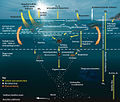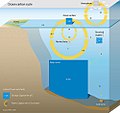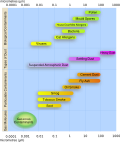 | Particulate inorganic carbon (PIC) can be contrasted with dissolved inorganic carbon (DIC), the other form of inorganic carbon found in the ocean. These... 60 KB (6,029 words) - 21:10, 4 January 2024 |
 | Total inorganic carbon (CT or TIC) is the sum of the inorganic carbon species. Carbon compounds can be distinguished as either organic or inorganic, and... 8 KB (960 words) - 02:44, 27 December 2023 |
 | Biological pump (redirect from Biological carbon pump) dissolved inorganic carbon (DIC) into organic biomass and pumping it in particulate or dissolved form into the deep ocean. Inorganic nutrients and carbon dioxide... 145 KB (16,299 words) - 20:02, 23 April 2024 |
 | of carbon between land and water as methane, dissolved organic carbon, dissolved inorganic carbon, particulate inorganic carbon, and particulate organic... 58 KB (6,927 words) - 12:51, 28 March 2024 |
 | the amount of non-organic carbon, like carbon in carbonate minerals. Subtracting the inorganic carbon from the total carbon yields TOC. Another common... 30 KB (3,901 words) - 15:16, 9 January 2024 |
 | C4 carbon fixation or the Hatch–Slack pathway is one of three known photosynthetic processes of carbon fixation in plants. It owes the names to the 1960s... 38 KB (4,484 words) - 09:13, 17 April 2024 |
 | Carbonate–silicate cycle (redirect from Inorganic carbon cycle) The carbonate–silicate geochemical cycle, also known as the inorganic carbon cycle, describes the long-term transformation of silicate rocks to carbonate... 21 KB (2,540 words) - 10:01, 13 August 2023 |
 | Soil carbon is the solid carbon stored in global soils. This includes both soil organic matter and inorganic carbon as carbonate minerals. It is vital... 38 KB (4,230 words) - 03:52, 29 April 2024 |
 | A carbon-to-nitrogen ratio (C/N ratio or C:N ratio) is a ratio of the mass of carbon to the mass of nitrogen in organic residues. It can, amongst other... 17 KB (2,254 words) - 10:36, 14 April 2024 |
 | 7 micrometers. The fraction remaining on the filter is called particulate organic carbon (POC). Dissolved organic matter (DOM) is a closely related term... 79 KB (9,614 words) - 15:45, 19 April 2024 |
 | Carbon dioxide removal (CDR) is a process in which carbon dioxide (CO2) is removed from the atmosphere by deliberate human activities and durably stored... 51 KB (5,731 words) - 08:49, 11 April 2024 |
 | Solubility pump (category Carbon cycle) solubility pump is a physico-chemical process that transports carbon as dissolved inorganic carbon (DIC) from the ocean's surface to its interior. The solubility... 9 KB (1,061 words) - 13:17, 2 October 2023 |
 | nutrient cycle (or ecological recycling) is the movement and exchange of inorganic and organic matter back into the production of matter. Energy flow is... 51 KB (5,266 words) - 18:54, 24 March 2024 |
 | Marine snow (section Carbon cycling) 98% of the dissolved inorganic carbon pool, along with a rapid sedimentation rate that results in low particulate organic carbon inputs. It is yet to... 22 KB (2,748 words) - 23:37, 14 December 2023 |
Programmable interrupt controller, an integrated circuit type Particulate inorganic carbon, found in the ocean Paid-in capital, contributed to a corporation... 4 KB (563 words) - 12:45, 26 February 2024 |













